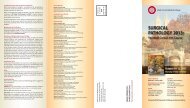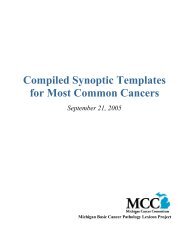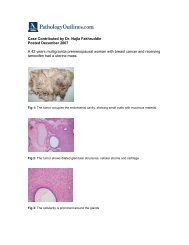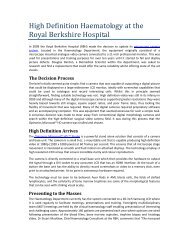CHAPTER 3 Tumours of the Stomach - Pathology Outlines
CHAPTER 3 Tumours of the Stomach - Pathology Outlines
CHAPTER 3 Tumours of the Stomach - Pathology Outlines
You also want an ePaper? Increase the reach of your titles
YUMPU automatically turns print PDFs into web optimized ePapers that Google loves.
firmed <strong>the</strong> transformation <strong>of</strong> low-grade to<br />
high-grade lymphoma in <strong>the</strong> majority <strong>of</strong><br />
cases {1263} while in o<strong>the</strong>r cases both<br />
components appear clonally unrelated,<br />
suggesting <strong>the</strong> development <strong>of</strong> a second<br />
primary lymphoma {1184, 1491}.<br />
Molecular genetics <strong>of</strong> MALT lymphomas<br />
Early studies confirmed <strong>the</strong> presence <strong>of</strong><br />
immunoglobulin gene rearrangement in<br />
each case {1803} and suggested that<br />
<strong>the</strong>re was no involvement <strong>of</strong> <strong>the</strong> bcl-1 or<br />
bcl-2 oncogenes {2136}. The translocation<br />
t(11;18)(q21;q21) has been identified<br />
in a significant number <strong>of</strong> low-grade<br />
MALT lymphomas and may be <strong>the</strong> sole<br />
genetic alteration in <strong>the</strong>se cases. However,<br />
this translocation appears to be less<br />
common in high-grade lesions {1435, 95}.<br />
Trisomy 3 has been detected in up to 60%<br />
<strong>of</strong> cases in some studies using both<br />
metaphase and interphase techniques<br />
{2134, 2137}, but this finding has not<br />
been confirmed by o<strong>the</strong>r studies {1434}.<br />
The translocation t(1;14) (p22; q32) has<br />
also been described in a small proportion<br />
<strong>of</strong> cases {2138} and this is associated<br />
with increased survival <strong>of</strong> tumour cells in<br />
unstimulated cell culture. Cloning <strong>of</strong> <strong>the</strong><br />
breakpoint involved in this translocation<br />
has led to <strong>the</strong> discovery <strong>of</strong> a novel gene,<br />
bcl-10, on chromosome 1 that may be<br />
significant in determining <strong>the</strong> behaviour <strong>of</strong><br />
MALT lymphomas {2116}.<br />
Studies <strong>of</strong> <strong>the</strong> immunoglobulin gene <strong>of</strong><br />
MALT lymphoma cells has shown <strong>the</strong><br />
sequential accumulation <strong>of</strong> somatic<br />
mutations, consistent with an ongoing,<br />
antigen driven selection and proliferation<br />
{279, 434, 1546}. Study <strong>of</strong> <strong>the</strong> third complementary<br />
determining region <strong>of</strong> <strong>the</strong><br />
immunoglobulin heavy chain gene shows<br />
a pattern <strong>of</strong> changes associated with <strong>the</strong><br />
generation <strong>of</strong> antibody diversity and<br />
increased antigen binding affinity {131}.<br />
Transformation <strong>of</strong> low-grade MALT lymphoma<br />
to a high-grade lesion has been<br />
associated with several genetic alterations.<br />
While <strong>the</strong> t(11;18) chromosomal<br />
translocation is not seen in high-grade<br />
MALT lymphoma and may be protective<br />
against transformation, alterations in <strong>the</strong><br />
genes coding for p53, p16, c-myc and<br />
trisomy 12 have all been identified in<br />
high-grade lesions {1489, 1490, 1341,<br />
270, 435, 1992}. Bcl-6 protein has also<br />
been described in high-grade lymphomas<br />
while being absent from lowgrade<br />
lesions {1425}. Some studies have<br />
shown a high level <strong>of</strong> bcl-6 gene hypermutations<br />
in diffuse large B-cell lymphomas<br />
independent <strong>of</strong> a rearrangement<br />
<strong>of</strong> <strong>the</strong> gene {1070}. Epstein-Barr virus is<br />
not associated with low-grade lymphomas<br />
and has only been seen in some<br />
high-grade lymphomas {1038, 1437}.<br />
Mantle cell lymphoma<br />
Mantle cell lymphoma <strong>of</strong> <strong>the</strong> stomach is<br />
typically a component <strong>of</strong> multiple lymphomatous<br />
polyposis <strong>of</strong> <strong>the</strong> gastrointestinal<br />
tract and infrequently encountered<br />
outside this clinical context {1380}.<br />
Morphologically and immunophenotypically,<br />
<strong>the</strong> lymphoma is indistinguishable<br />
from mantle cell lymphomas <strong>of</strong> lymph<br />
nodes, with a diffuse and monotonous<br />
infiltrate <strong>of</strong> cells with scanty cytoplasm<br />
and irregular nuclei that express B-cell<br />
markers toge<strong>the</strong>r with CD5 and cyclinD1.<br />
O<strong>the</strong>r low-grade B-cell lymphomas<br />
Although <strong>the</strong> lymphoid tissue in <strong>the</strong> stomach<br />
contains all <strong>the</strong> B-cell populations<br />
encountered in nodal lymphoid tissue,<br />
o<strong>the</strong>r low-grade B-cell lymphomas, such<br />
as follicle centre cell lymphomas, are<br />
very rare and usually indistinguishable<br />
from <strong>the</strong>ir nodal counterparts.<br />
Diffuse large B-cell lymphoma<br />
These lymphomas are morphologically<br />
indistinguishable from diffuse large B-cell<br />
lymphomas that arise within lymph<br />
nodes. There is complete destruction <strong>of</strong><br />
<strong>the</strong> gastric glandular architecture by<br />
large cells with vesicular nuclei and<br />
prominent nucleoli. Variants <strong>of</strong> large B-<br />
cell lymphoma (e.g. plasmablastic lymphoma)<br />
may also be encountered {1541}.<br />
Burkitt lymphoma<br />
Although rare, classical Burkitt lymphomas<br />
may be encountered in <strong>the</strong><br />
stomach {55}. The morphology is identical<br />
to that <strong>of</strong> Burkitt lymphoma encountered<br />
elsewhere, with diffuse sheets <strong>of</strong><br />
medium sized cells with scanty cytoplasm<br />
and round/oval nuclei containing<br />
small nucleoli. Within <strong>the</strong> sheets <strong>the</strong>re are<br />
numerous macrophages, giving a ‘starrysky’<br />
appearance. Mitoses are frequent<br />
and apoptotic debris abundant. The<br />
cells express CD10 in addition to<br />
pan-B-cell markers. Close to 100% <strong>of</strong><br />
nuclei are immunoreactive for Ki-67.<br />
T-cell lymphoma<br />
Primary gastric T-cell lymphomas are<br />
rare. Most have been reported from<br />
areas <strong>of</strong> endemic HTLV-1 infection and<br />
probably represent gastric manifestations<br />
<strong>of</strong> adult T-cell leukemia/lymphoma<br />
(ATLL). In <strong>the</strong>se regions, T-cell lymphoma<br />
may represent up to 7% <strong>of</strong> gastric lymphomas<br />
{1741}. Most <strong>of</strong> <strong>the</strong> remainder<br />
are similar to peripheral T-cell lymphomas<br />
encountered in lymph nodes but<br />
occasionally, gastric NK cell lymphomas<br />
are also seen {1741}. It has recently<br />
been demonstrated that some gastric<br />
T-cell lymphomas display features <strong>of</strong><br />
intraepi<strong>the</strong>lial T lymphocyte differentiation<br />
(e.g. expression <strong>of</strong> <strong>the</strong> human<br />
mucosal lymphocyte 1 antigen, CD103),<br />
similar to those seen in intestinal T-cell<br />
lymphomas {520}.<br />
Hodgkin disease<br />
Hodgkin disease may involve <strong>the</strong> gastrointestinal<br />
tract but this is usually secondary<br />
to nodal disease. Primary gastric<br />
Hodgkin disease is very rare {2210}.<br />
Prognosis and predictive factors<br />
Studies on <strong>the</strong> regression <strong>of</strong> low-grade<br />
MALT lymphoma through H. pylori eradication<br />
have shown remission in 67-84%<br />
<strong>of</strong> cases {1926, 1520, 2133}, but this<br />
applies only to low-grade lesions and is<br />
most effective for lesions showing superficial<br />
involvement <strong>of</strong> <strong>the</strong> gastric wall.<br />
Although remission following H. pylori<br />
eradication has occasionally been seen<br />
in advanced tumours, <strong>the</strong> highest success<br />
rate <strong>of</strong> 90-100% is seen in tumours<br />
confined to <strong>the</strong> mucosa and superficial<br />
submucosa. The time taken to achieve<br />
remission in <strong>the</strong>se patients varies from<br />
4-6 weeks to 18 months. The stability <strong>of</strong><br />
<strong>the</strong>se remissions remains to be determined;<br />
one study has reported a relapse<br />
in 10% <strong>of</strong> patients after a mean follow-up<br />
period <strong>of</strong> 24 months {1338} while o<strong>the</strong>rs<br />
have found sustained remissions for up<br />
to six years {801}.<br />
Surgical resection is associated with prolonged<br />
survival {552} in many cases.<br />
Involvement <strong>of</strong> <strong>the</strong> resection margins and<br />
advanced stage are poor prognostic features,<br />
but not with <strong>the</strong> addition <strong>of</strong><br />
chemo<strong>the</strong>rapy {1262}. Irrespective <strong>of</strong><br />
treatment modality, <strong>the</strong> only significant<br />
independent prognostic variables are<br />
stage and tumour-grade {260, 1653,<br />
1262, 320, 383}.<br />
Lymphoma<br />
61
















